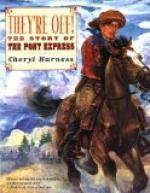By the close of 1859 there were at least six different mail routes across the continent from the Missouri to the Pacific Coast. They were costing the Government a total of $2,184,696.00 and returning $339,747.34. The most expensive of these lines was the New York and New Orleans Steamship Company route, which ran semi-monthly from New York to San Francisco via Panama. This service cost $738,250.00 annually and brought in $229,979.69. While the steamship people did not have the frontier dangers to confront them, they were operating over a roundabout course, several thousand miles in extent, and the volume of their postal business was simply inadequate to meet the expense of maintaining their business[36].
The steamer schedule was about four weeks in either direction, and the rapidly increasing population of California soon demanded, in the early fifties, a faster and more frequent service. Agitation to that end was thus started, and during the last days of Pierce’s administration, in March 1857, the “Overland Mail” bill was passed by Congress and signed by the President. This act provided that the Postmaster-General should advertise for bids until June 30 following: “for the conveyance of the entire letter mail from such point on the Mississippi River as the contractors may select to San Francisco, Cal., for six years, at a cost not exceeding $300,000 per annum for semi-monthly, $450,000 for weekly, or $600,000 for semi-weekly service to be performed semi-monthly, weekly, or semi-weekly at the option of the Postmaster-General.” The specifications also stipulated a twenty-five day schedule, good coaches, and four-horse teams.
Bids were opened July 1, 1857. Nine were submitted, and most of them proposed starting from St. Louis, thence going overland in a southwesterly direction usually via Albuquerque. Only one bid proposed the more northerly Central route via Independence, Fort Laramie, and Salt Lake. The Postoffice Department was opposed to this trail, and its attitude had been confirmed by the troubles of winter travel in the past. In fact this route had been a failure for six consecutive winters, due to the deep snows of the high mountains which it crossed.
On July 2, 1857, the Postmaster General announced the acceptance of bid No. “12,587” which stipulated a forked route from St. Louis, Missouri and from Memphis, Tennessee, the lines converging at Little Rock, Arkansas. Thence the course was by way of Preston, Texas; or as nearly as might be found advisable, to the best point in crossing the Rio Grande above El Paso, and not far from Fort Filmore; thence along the new road then being opened and constructed by the Secretary of the Interior to Fort Yuma, California; thence through the best passes and along the best valleys for safe and expeditious staging to San Francisco. On September is following, a six year contract was let for this route. The successful firm at once became known as the “Butterfield Overland Mail




